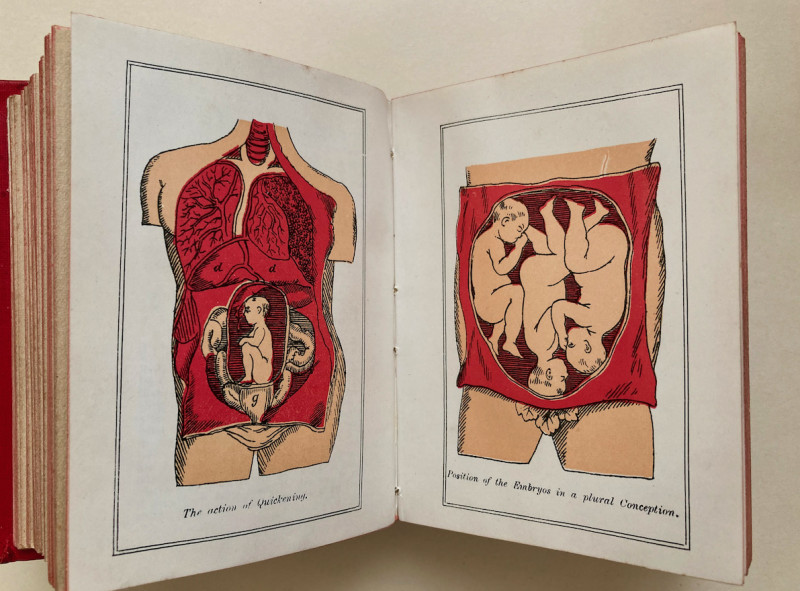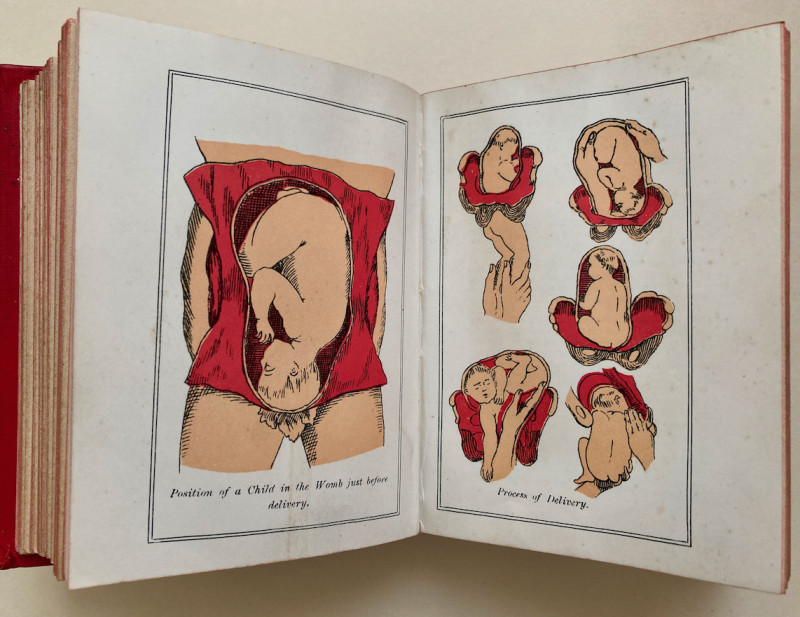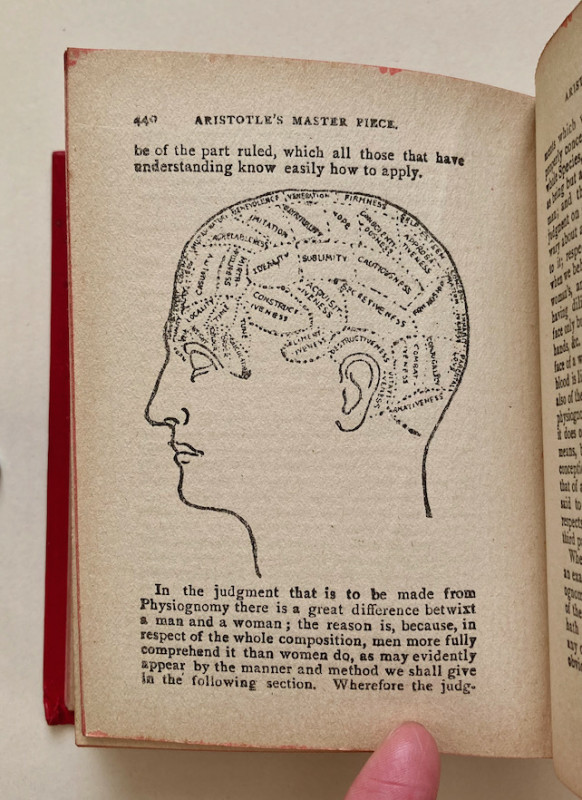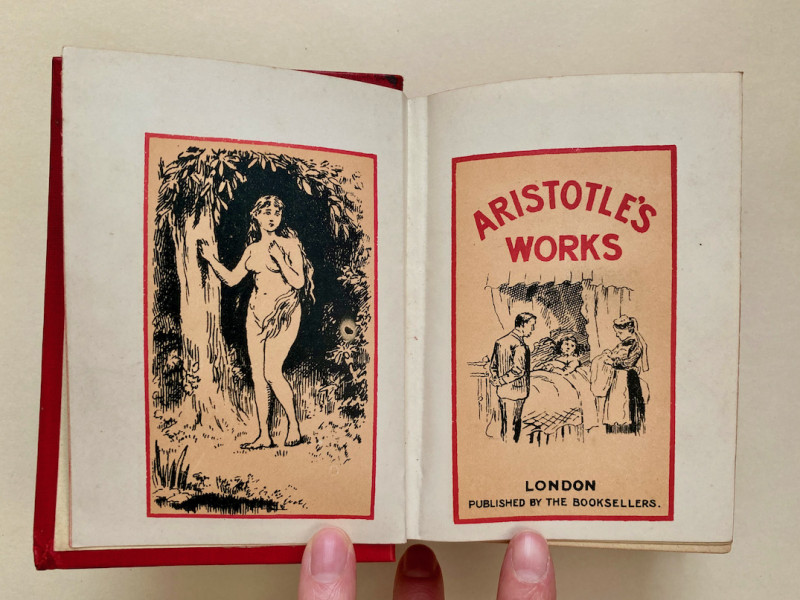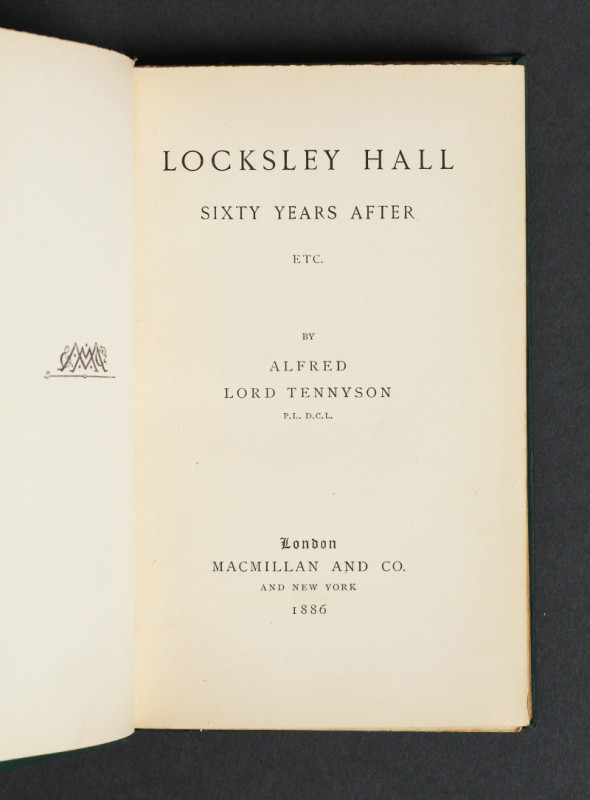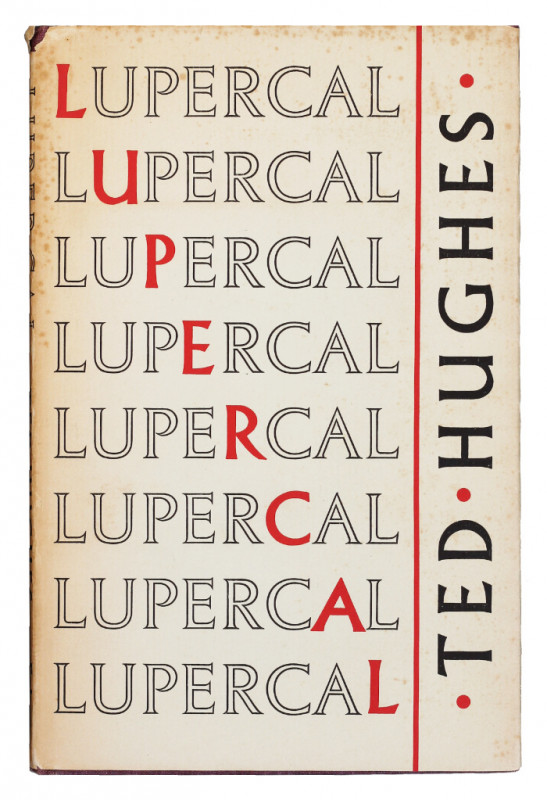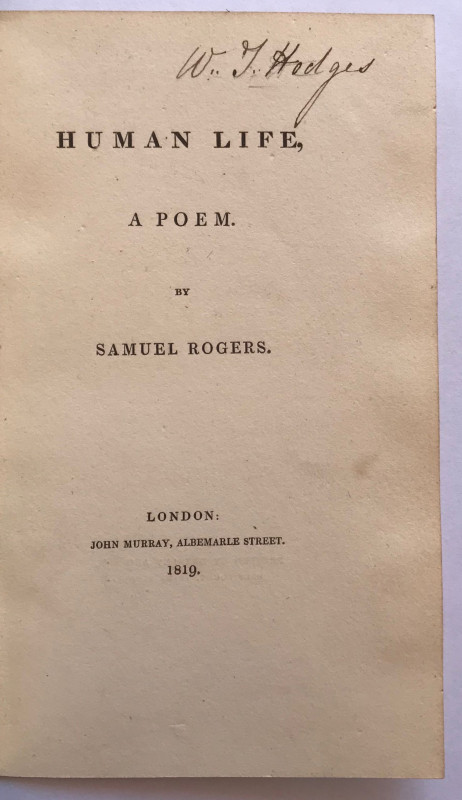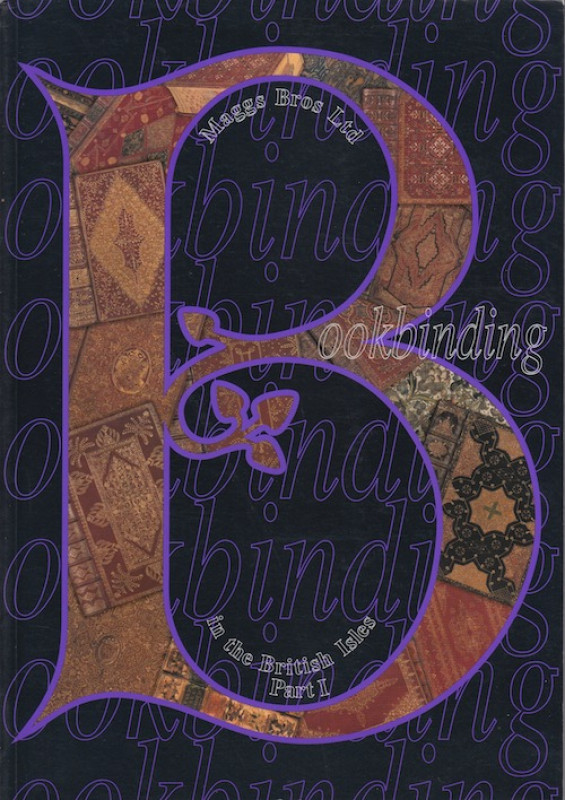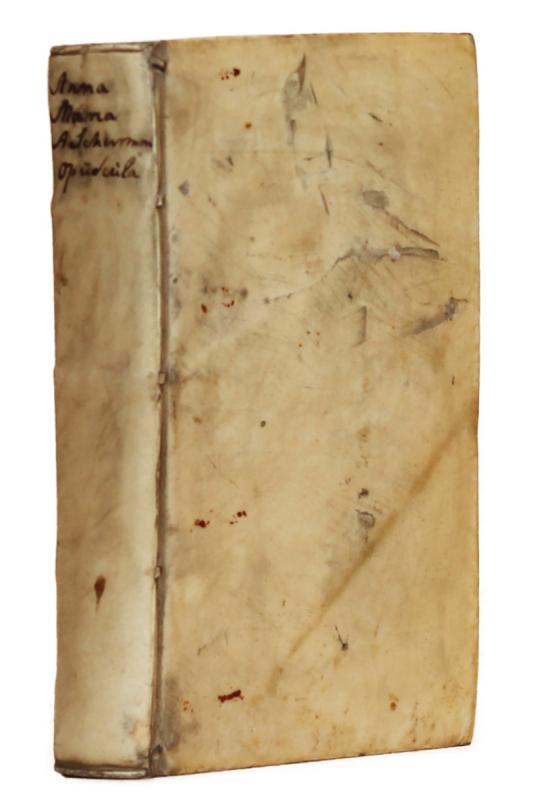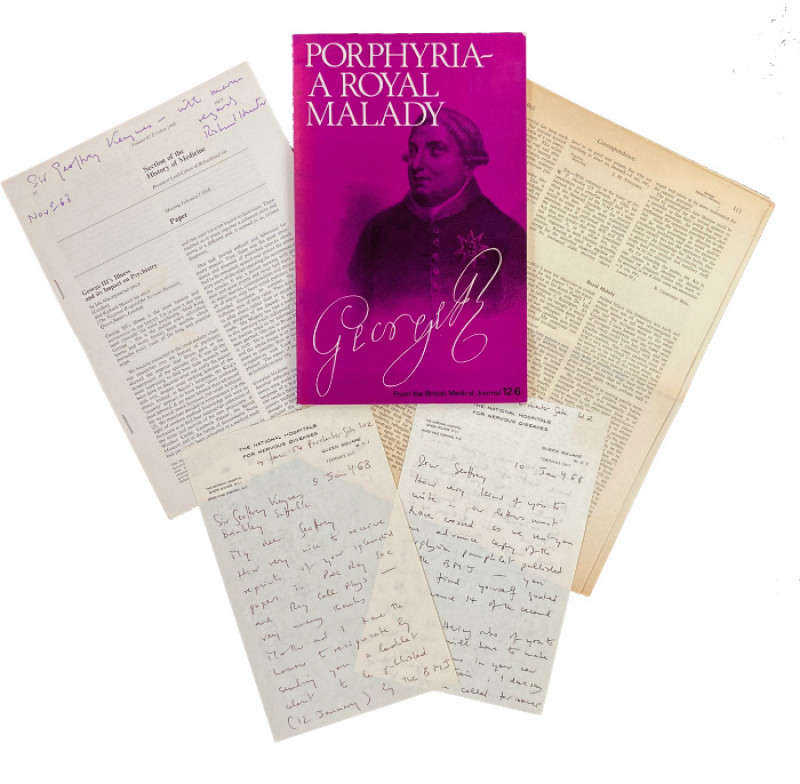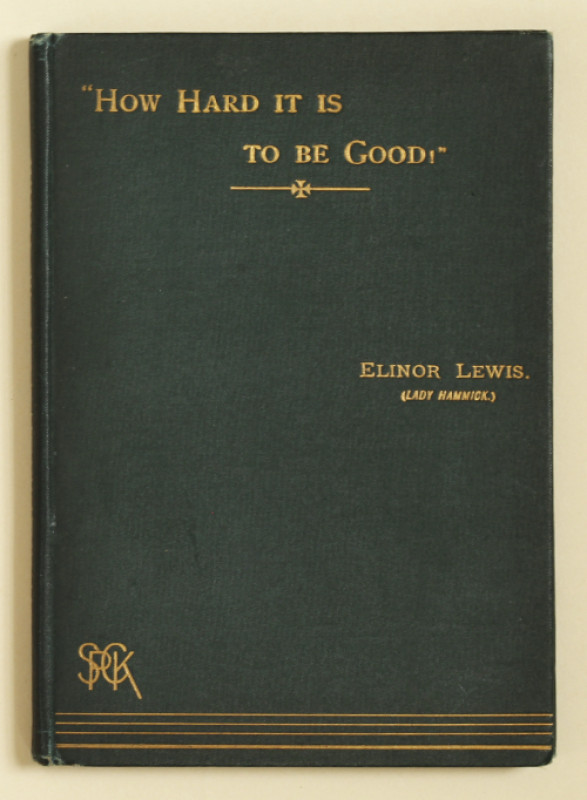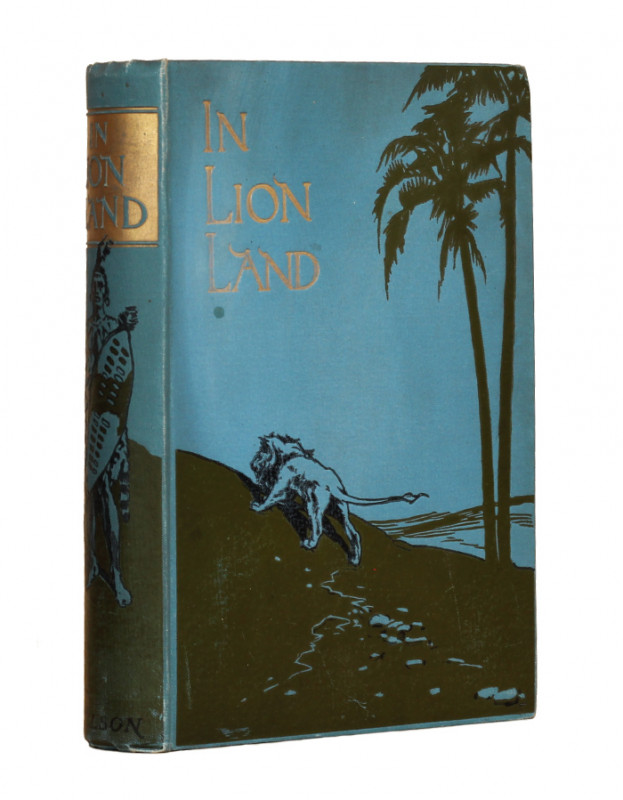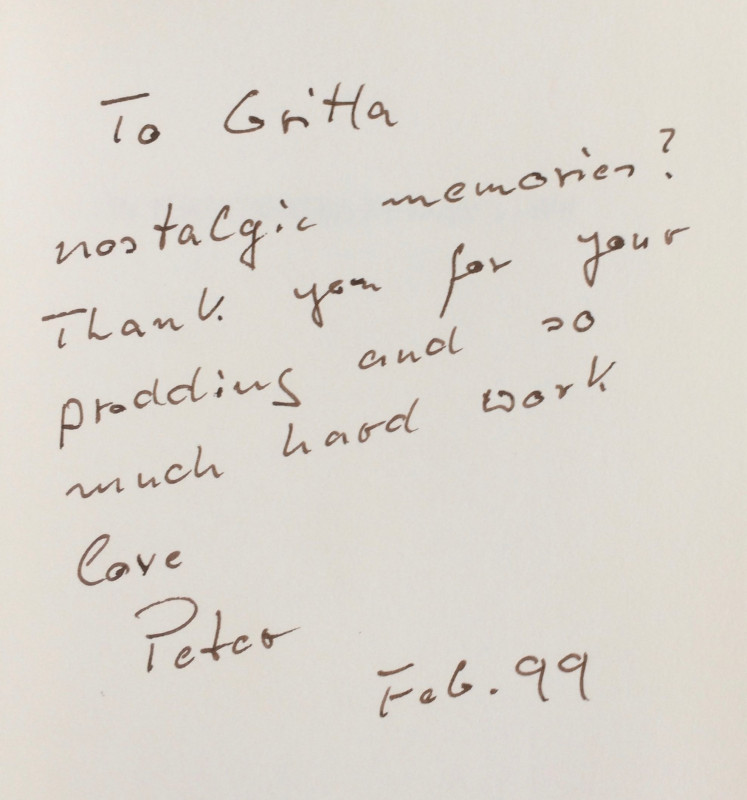The Works of Aristotle, the Famous Philosopher, Containing I. His Complete Masterpiece...
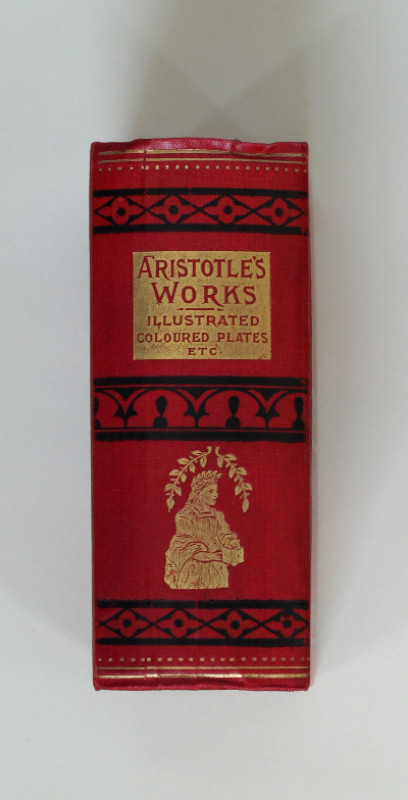


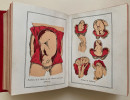


Book Description
PSEUDO-ARISTOTLE ON WHAT TO EXPECT WHEN YOU’RE EXPECTING & FAMILY HEALTH
Full title: The Works of Aristotle, the Famous Philosopher, Containing I. His Complete Masterpiece. II. His Experienced Midwife. III. His Book of Problems. IV. His Remarks on Physiognomy. V. The Family Physician. New and Improved Edition with Coloured Plates.
Sextodecimo (122 x 90mm), pp. 528. Lithographic frontispiece printed in red and black on an ochre ground depicting a nude young woman beneath a tree, lithographic additional title printed in red and black on an ochre ground (‘Aristotle’s Works’ with imprint ‘London published by the Booksellers’) with vignette depicting a new-born baby and mother, and 6 lithographic plates printed in red, ochre, and black, all all printed on coated stock. Wood-engraved illustrations in the text. (Some even light browning due to poor-quality paper stock, l. [M]8 torn at lower corner causing small marginal loss.) Original red cloth, boards blocked in black with 3 decorative bands running horizontally across the upper board, spine, and lower board, upper board with further leafy sprays surrounding central band, spine blocked in gilt with title-panel between the upper 2 bands (‘ARISTOTLE’S WORKS / ILLUSTRATED / COLOURED PLATES / ETC.’) and gilt design of [?]Aristotle wearing a laurel wreath and proffering an open book between the lower 2 bands, spine-ends ruled in gilt and decorated with rows of gilt dots, coated light-yellow endpapers, all edges red. (Spine-ends lightly bumped, corners bumped, fore-edge of lower board more heavily bumped, causing small surface losses.) A very good copy in the original cloth.
Full title: The Works of Aristotle, the Famous Philosopher, Containing I. His Complete Masterpiece. II. His Experienced Midwife. III. His Book of Problems. IV. His Remarks on Physiognomy. V. The Family Physician. New and Improved Edition with Coloured Plates.
Dealer Notes
‘New and Improved Edition’. In the early modern period, the popularity of manuals on conception, pregnancy and childbirth – especially Nicolas Culpeper’s Directory for Midwives (1651) – intersected with the continued popularity of Aristotelian works and the skills of writers and booksellers in reacting quickly to such trends for their own benefit. In this environment, the pseudo-Aristotelian Aristotle’s Masterpiece (first published in 1684) became ‘the best-selling guide to pregnancy and childbirth’ and witnessed ‘more editions than all other popular works on the topic combined’ through to the late nineteenth century (Mary E. Fissell, ‘Hairy Women and Naked Truths: Gender and the Politics of Knowledge in Aristotle’s Masterpiece’, The William and Mary Quarterly 60 (2003), pp. 43-74, at p. 43). Indeed, such was its impact on popular culture that references to it can be found in the literature of the early twentieth century; for example, Leopold Bloom is shown a copy in a Dublin bookshop in James Joyce’s Ulysses (1922) and references to the text recur in the novel, while the second chapter of Evelyn Waugh’s Vile Bodies (1930) describes customs officers at Dover searching Adam Fenwick-Symes’ luggage for banned books, and consulting a list ‘which began “Aristotle, Works of (Illustrated)”’.
The first edition of the text, which appears to have survived in three main states, was a combination mostly of Levinus Lemnius’ Secret Miracles of Nature (1559, first and only English edition 1658) and the anonymous Complete Midwives Practice, which was itself a compilation of earlier texts, and the text was revised, reworked, and modified throughout the following two centuries. The present copy appears to be one of a number of variant editions produced in the latter part of the nineteenth century, which continued the tradition of making these topics attractive to a popular audience, through the use of red, ochre, and black lithographic plates as illustrations. The frontispiece of this copy depicts a nude woman beneath a tree (possibly of knowledge) and the facing, additional title shows a new-born baby held by a nurse or midwife, while the resting mother lies in bed looking at the baby and a male figure (possibly a physician) observes. The six plates in the main body of the work are somewhat stylised anatomical sections and illustrate the position of the child in the womb in single and multiple pregnancies; the development of the embryo month-by-month from conception to delivery; the position of a child in the womb immediately prior to delivery; and the ‘Process of Delivery’. The anatomical illustrations in the text can be related to those in earlier editions, and show physical abnormalities from the wonderous to the monstrous, while other woodcuts illustrate sections on phrenology and palmistry.
The textual contents are comprehensive and interesting, and the first two sections discuss many aspects of sexual health, conception, and childbirth, from virginity to the assignation of the child’s sex in the womb; from the difficulties and complexities of conception to the perils of each month of pregnancy; and from the progress of and complications in childbirth to children’s diseases. They are followed by Aristotle’s ‘Book of Problems’, which debates physiology using a question-and-answer structure (e.g. ‘Why have you one nose and two eyes?’ or ‘From whence do nails proceed?’) and is followed by his ‘Remarks on Physiognomy’, which explains physiognomy and the practices within the field, such as phrenology, palmistry, and other means of interpreting personality or character through aspects of the body. The final section, titled ‘The Family Physician, being Choice and Approved Remedies for the Several Distempers Incident to the Human Body’ is more practical, and is divided into two parts. The first offers recipes for remedies such as ‘A Vomit for a Swimming in the Head’, ‘An Ointment for the Itch’, ‘A Distilled Water for the Jaundice’, and ‘For St. Anthony’s Fire’, and the second part is an alphabetical glossary of illnesses (‘Ague’, ‘Anaemia’, ‘Angina Pectoris’, etc.), providing definitions and recommended treatments. Taken together, these sections give the reader a comprehensive account of not only conception and childbirth, but also a broad spectrum of domestic medical issues.
This edition is rare and we cannot trace a copy which matches ours in UK institutional collections via JISC Library Hub Discover (although a copy in the Warburg Institute bears the same title, it only has 270 pages).
The first edition of the text, which appears to have survived in three main states, was a combination mostly of Levinus Lemnius’ Secret Miracles of Nature (1559, first and only English edition 1658) and the anonymous Complete Midwives Practice, which was itself a compilation of earlier texts, and the text was revised, reworked, and modified throughout the following two centuries. The present copy appears to be one of a number of variant editions produced in the latter part of the nineteenth century, which continued the tradition of making these topics attractive to a popular audience, through the use of red, ochre, and black lithographic plates as illustrations. The frontispiece of this copy depicts a nude woman beneath a tree (possibly of knowledge) and the facing, additional title shows a new-born baby held by a nurse or midwife, while the resting mother lies in bed looking at the baby and a male figure (possibly a physician) observes. The six plates in the main body of the work are somewhat stylised anatomical sections and illustrate the position of the child in the womb in single and multiple pregnancies; the development of the embryo month-by-month from conception to delivery; the position of a child in the womb immediately prior to delivery; and the ‘Process of Delivery’. The anatomical illustrations in the text can be related to those in earlier editions, and show physical abnormalities from the wonderous to the monstrous, while other woodcuts illustrate sections on phrenology and palmistry.
The textual contents are comprehensive and interesting, and the first two sections discuss many aspects of sexual health, conception, and childbirth, from virginity to the assignation of the child’s sex in the womb; from the difficulties and complexities of conception to the perils of each month of pregnancy; and from the progress of and complications in childbirth to children’s diseases. They are followed by Aristotle’s ‘Book of Problems’, which debates physiology using a question-and-answer structure (e.g. ‘Why have you one nose and two eyes?’ or ‘From whence do nails proceed?’) and is followed by his ‘Remarks on Physiognomy’, which explains physiognomy and the practices within the field, such as phrenology, palmistry, and other means of interpreting personality or character through aspects of the body. The final section, titled ‘The Family Physician, being Choice and Approved Remedies for the Several Distempers Incident to the Human Body’ is more practical, and is divided into two parts. The first offers recipes for remedies such as ‘A Vomit for a Swimming in the Head’, ‘An Ointment for the Itch’, ‘A Distilled Water for the Jaundice’, and ‘For St. Anthony’s Fire’, and the second part is an alphabetical glossary of illnesses (‘Ague’, ‘Anaemia’, ‘Angina Pectoris’, etc.), providing definitions and recommended treatments. Taken together, these sections give the reader a comprehensive account of not only conception and childbirth, but also a broad spectrum of domestic medical issues.
This edition is rare and we cannot trace a copy which matches ours in UK institutional collections via JISC Library Hub Discover (although a copy in the Warburg Institute bears the same title, it only has 270 pages).
Author
ARISTOTLE, pseud.
Date
[c. 1870-1900]
Publisher
London: ‘published by The Booksellers’
Friends of the PBFA
For £10 get free entry to our fairs, updates from the PBFA and more.
Please email info@pbfa.org for more information
